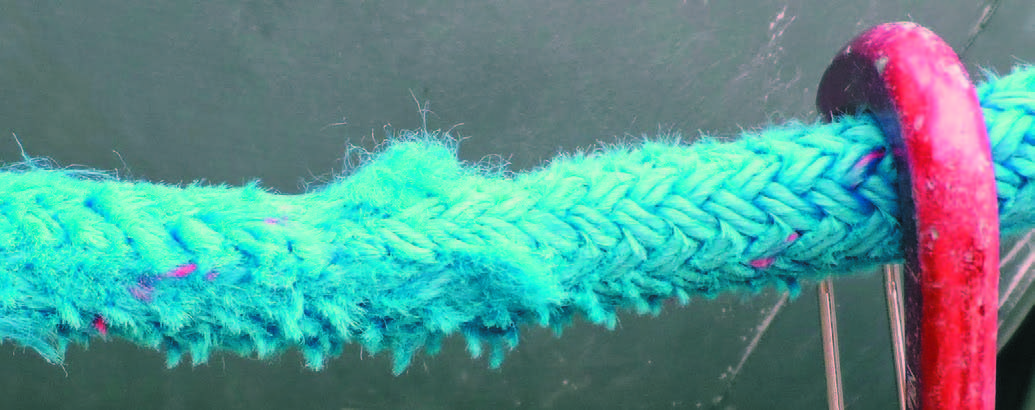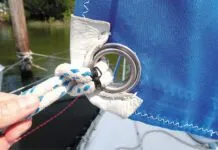Jack Russell is on watch
Regarding your recent Inside Practical Sailor blog post on ideal dogs for boats, I believe Jack Russell terrier, Parson Russell Terrier or many of the smaller terriers are ideally suited. Nimble, determined and easily adapt as long as their people are there. Easy to board the dinghy or back on the boat. Their food storage doesn’t gobble up too much storage space and never will a rodent live for more than moments on your boat. They will easily adjust to the cruising life schedule. They are really large dogs trapped in small bodies that are easily managed on board with training.
Wendy and Jeff Henderson
Wonder, Caliber 40 LRC
Westport, MA
King Charles Spaniels Rule
Our acceptable boat dog is Lady, a 14.5 pound Cavalier King Charles Spaniel. This picture was taken on Old School, a 1967 Cal 30. We recently purchased a 2002 Hunter 326 and Lady has made the adjustment without issue. For those of you who know Cavaliers you will know how low maintenance, loyal and loving they are. We are freshwater sailors and our lake has 1,200 miles of shoreline so plenty of room for gunkholing. When Lady came into our family some years ago we did upgrade our dinghy from a tandem sit-on-top to an eleven foot fiberglass dink with a 3.5 Mercury. No complaints from any of the crew when we dinghy over to shore a couple two three times a day for potty purposes.
Bobby Centers
Harmony, Hunter 326,
Appling, GA

Anchors and Line Coatings
Your online archive report Sewn Splices, Two-year Follow-up, (PS June 2016) and the blog Anchor Designs for Soft Mud (Inside Practical Sailor blog) are very informative. Two questions: Are any of these products recommended for use on mooring pennants? I upgraded my main halyard and it no longer is reliably held by the Lewmar rope clutch, resulting in loss of tension before I can get it to the cleat. Would you know of any products that might help?
As for the recent Inside Practical Sailor blog post discussing anchors for mud. It seems like claw-type anchors these would set well in soft bottoms, though perhaps not as well as the fluke-type.
Peter Newton
1982 Bristol 35.5
Mattapoisett, MA

As reported in a sidebar to that June 2016 article on sewn splices, Maxijacket is very good for protecting dock lines, exposed core in core-dependent splices, and splices in general. However, it stiffens the line and is not recommended for use on portions of lines that will be handled, go around winches, or pass through clutches or jammers. On the other hand, Spinlock RP25 does not significantly stiffen the line, though we would still not use it on sections of lines to be handled or go around winches. Thus, Spinlock RP 25 is a good choice for reducing minor wear and reducing slipping in clutches. Weve not thoroughly yet tested either for holding in rope clutches, which we last evaluated in November 2014. Another option is to try a new cover-or even your old cover-on the new halyard, assuming it is a double braid (see Splicing a Polyethylene Cover, PS December 2018). Test a short section first before dissembling your new halyard.
As for the claw anchors in mud, we tested the Lewmar claw (based on the original Scottish Bruce design) and several others in 2006. Testers found that, indeed, the claw held well, presumably because of its large fluke area and concave shaped fluke (see PS February 2006). We also tested a 118-pound Manson Ray, a larger version of the Bruce design, in a variety of challenging bottom, and it held and set exceptionally well. It is important to remember that results are not always scalable between anchors of different sizes. Based on our experience, and anecdotal evidence, the Bruce design, in particular, seems to be more effective in the larger sizes (greater than 33 pounds).

Cleat Confusion
One of the things I really like about Practical Sailor, and a reason I am a long-term subscriber, is the diversity of subjects covered by your magazine. Even after sailing for six decades if I can learn just one useful bit of information per issue I feel my subscription is more than justified. Besides, one never knows when that information may help avoid trouble.
I would also note, that to safely skipper a sailboat (or a powerboat) it is important that all actions should be performed to the very best of your ability. One cannot learn item A, and then forget to perform item B. Or learn to do item C, and then utterly botch item E. This brings me to the photograph on page 14 in the February 2019 issue of Practical Sailor. In the middle of an otherwise excellent article on the threat of internal heat developing in anchor rodes, dock lines, jacklines, etc, a line is shown passing through a chock and then led at a sharp (viz. roughly 90 degree) angle to a cleat. The intent of the photograph was, I presume, to illustrate the increase in heat build-up when a line is led at a sharp angle. I understand, and this is very good point. Unfortunately the photograph also shows the line belayed to a cleat using a hitch that resembles a dogs breakfast!
One of the very first things I show newcomers after they board our beloved Catalina 34 Pleiades is how to properly belay a line to a cleat. The photograph on page 14 is NOT how to do it! I am sure PS has had prior articles on important knots for a range of marine applications. I also expect that PS showed the proper way to belay a line to a cleat.

My point in sending this note: don’t undo one lesson while providing another.
Finally, Catalina, while a popular manufacturer of sailboats for the average day-sailing or cruising sailor, is surely not a high end sailboat manufacturer. Nonetheless, I absolutely love the fact that for many years Catalina has utilized cleats located immediately on reinforced gunwales; thereby totally eliminating chocks, chock abrasion, and excessive heat build up in dock lines or mooring pendants, and all the related issues of sharp angles similar to that shown in your photograph. I have never seen an article, or discussion properly praising this simple design strategy!
Dr. Paul F. Jacobs
Catalina 34 Pleaides
Warwick, RI
Excellent point. Your ire for this dogs breakfast is shared by Clifford W. Ashley, author of the classic Ashley Book of Knots, who called this beauty an anti-Galligan (Ashley #1615). Ashley traces the phrase anti-gallican, to the Napoleons rule, when the autocratic leader resurrected the French Catholic Gallican Church to serve his own purpose of consolidating power. According to Ashley, this is the most polite name he could think of for this type of belay. In fact, that photo-found on a new boat at the Miami boat show-was provided as an example of how not to cleat a line in our Inside PS blog post How to Cleat a Line.

How much difference can a coating really make in fighting against line abrasion? This was one question we wanted to answer in our test of Yale Maxijacket in June 2016.
Heres what unprotected rope looks like after four years versus what protected line looks like after four years. The area non the left side of the frame where the rope is frayed is the unprotected area, the area on the right side of the frame is was protected with Maxijacket.




































